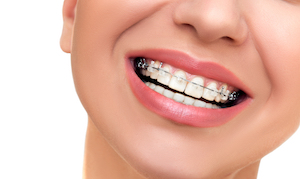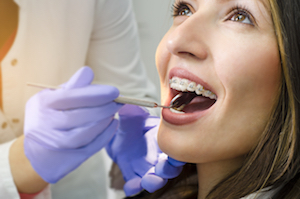
Bite Issues Cause Other Problems Too
The average person doesn’t pay much attention to the way their teeth come together. Or if they’ve ever thought about it, they may assume their bite is normal. After all – it’s typical for them. The truth is that many people who need braces don’t even realize it. They may even be experiencing other problems that are caused by an improper occlusion (bite) – that can be fixed through braces.
If you’ve never really looked at your bite, then keep the following in mind the next time you’re in front of a mirror:
- An Overbite: To a certain extent this is considered a normal bite. Our top teeth are naturally supposed to sit in front of our bottom teeth. However, where this becomes a problem is when our teeth significantly overlap the bottom ones. This is also known as a deep bite. In some cases, you won’t even see any bottom teeth at all. With this condition, there are usually some signs of wear from excessive pressure put on the teeth. This situation can lead to nerve exposure and tooth pain.
- An Underbite: This is the opposite of an overbite. You’ll see that your bottom front teeth actually sit in front of the top teeth. In severe cases, the lower jaw will appear to be protruded. This can cause pain and other issues with the TMJ (jaw) joint. Headaches and earaches can also occur.
- Crossbite: Here you see a combination of the two previous bites. Some teeth sit in front of each other, while others sit behind. These teeth can be extremely difficult to clean and are more prone to developing cavities.
- Open bite: This condition is most common in people that used a pacifier or sucked their thumb well into their childhood. With the back teeth bitten together, you’ll see that there’s an open gap between your front bottom and top teeth – which is where the pacifier or thumb used to go. When we’re young our mouth and facial features are forming. If we’re constantly using a pacifier, then our growing mouths will form to the shape of it. A deformed palate (roof of the mouth) can be seen in people that have an open bite. Biting into things and slurred speech is also common.
- Crowding: An excessive amount of crooked or crowded teeth are a problem. Some teeth may even be turned completely sideways. This is usually due to having a small mouth and a narrow arch. A person with this condition simply doesn’t have enough room for all of their teeth. Braces can be used to expand the arch and make more space. Crowding causes gum disease and tooth decay to develop more easily.
- Gaps: Large spaces between teeth make them difficult to clean and chewing can also be hard.
- Teeth that need to be moved vertically: Sometimes a tooth won’t be in line with other teeth and is set far into the gum.
Our orthodontist in Victoria, TX knows that not everyone is okay with the thought of having to wear metal braces. So for our patients that prefer a more aesthetically friendly look, there are other options to consider.

Types of Braces:
Clear or Ceramic Braces
Self-ligating braces, which are also available in a ceramic option, eliminate the use of elastic bands. A small clip on the bracket helps the teeth move with the wire that passes through them. This system tends to be more comfortable than the traditional form, causing less pressure and friction. They’re also easier to clean.
Fewer dental office visits are needed, and overall treatment time can even be cut down with self-ligating braces.
Self-Ligating Braces
Self-ligating braces, which are also available in a ceramic option, eliminate the use of elastic bands. A small clip on the bracket helps the teeth move with the wire that passes through them. This system tends to be more comfortable than the traditional form, causing less pressure and friction. They’re also easier to clean.
Fewer dental office visits are needed, and overall treatment time can even be cut down with self-ligating braces.
Lingual Braces
This option uses brackets and a wire that look much like conventional braces. However, these are placed on the back side of the teeth, which is a great thing for most adults that don’t like the idea of being seen with braces. But, there are a few requirements that can keep you from getting into lingual braces. They’re not suitable to treat all kinds of conditions and most importantly, your teeth have to be long enough to be able to hold the custom brackets in place. Some people find this system more challenging to wear because it’s hard for your tongue to leave the components alone and swallowing can be more difficult.
Invisalign Aligners
This nearly invisible form of orthodontics is a popular choice among the adult patients at our Victoria, TX orthodontist’s office. Invisalign systems uses the latest in 3-D digital technology to fabricate a series of clear plastic aligners that fit over your teeth and slowly move them. Each pair of trays is worn for two weeks, a minimum of 22 hours a day. They’re removable, which makes quick work of your dental hygiene routine. They have a smooth outside texture so they’re very comfortable to your lips, cheeks, and other soft tissue.
Invisalign treatment times are generally less than what traditional brackets and wires can take. In order to make sure you qualify for this option, we’ll need to evaluate your smile first.
Wait No Longer: Adult Braces in Victoria
With so many orthodontic treatment options available for adults today, there’s bound to be one that fits your budget and lifestyle. You deserve to have the smile that you’ve always wanted! Call our office today.
More to Explore

8:00am – 5:00pm
8:00am – 5:00pm
8:00am – 5:00pm
8:00am – 5:00pm
8:00am – 1:00pm